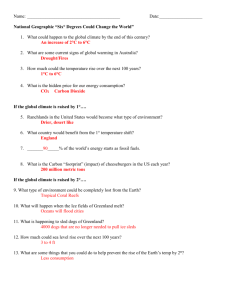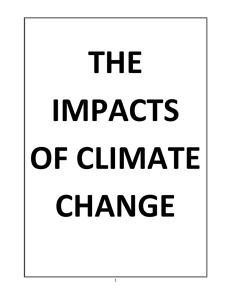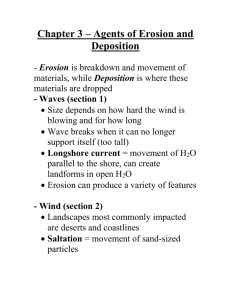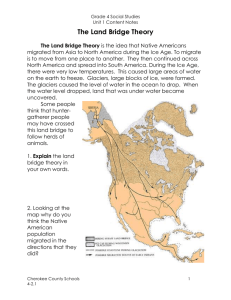Six degrees Summary - Sustainable Woodstock
advertisement
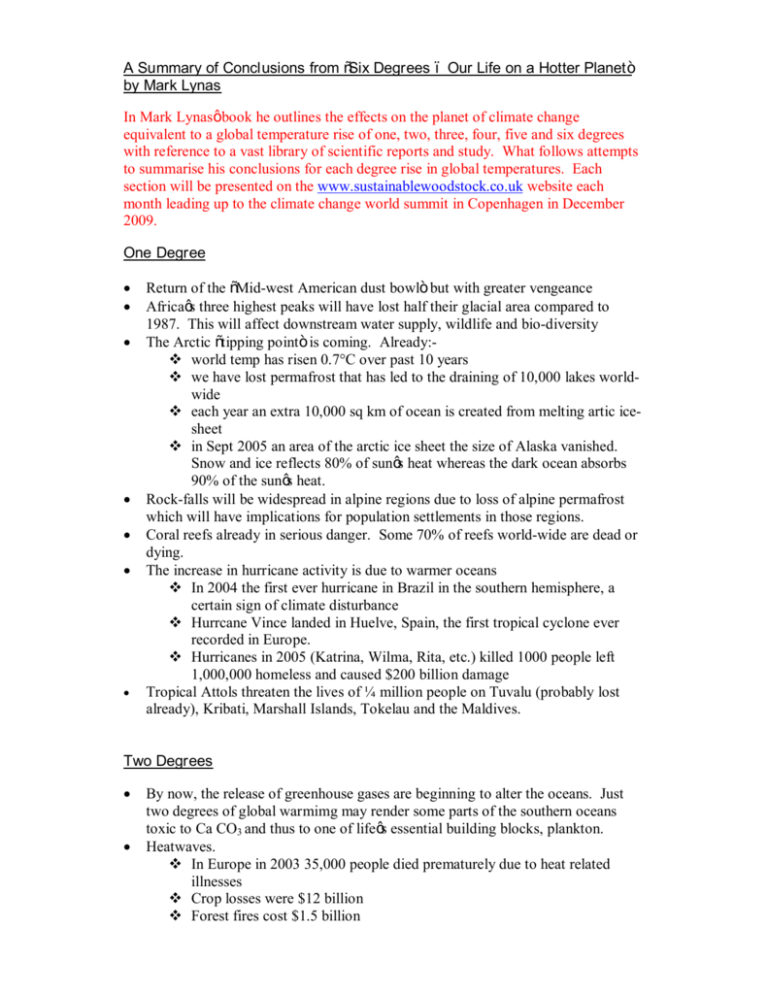
A Summary of Conclusions from “Six Degrees – Our Life on a Hotter Planet” by Mark Lynas In Mark Lynas’ book he outlines the effects on the planet of climate change equivalent to a global temperature rise of one, two, three, four, five and six degrees with reference to a vast library of scientific reports and study. What follows attempts to summarise his conclusions for each degree rise in global temperatures. Each section will be presented on the www.sustainablewoodstock.co.uk website each month leading up to the climate change world summit in Copenhagen in December 2009. One Degree · · · · · · · Return of the “Mid-west American dust bowl” but with greater vengeance Africa’s three highest peaks will have lost half their glacial area compared to 1987. This will affect downstream water supply, wildlife and bio-diversity The Arctic “tipping point” is coming. Already:v world temp has risen 0.7°C over past 10 years v we have lost permafrost that has led to the draining of 10,000 lakes worldwide v each year an extra 10,000 sq km of ocean is created from melting artic icesheet v in Sept 2005 an area of the arctic ice sheet the size of Alaska vanished. Snow and ice reflects 80% of sun’s heat whereas the dark ocean absorbs 90% of the sun’s heat. Rock-falls will be widespread in alpine regions due to loss of alpine permafrost which will have implications for population settlements in those regions. Coral reefs already in serious danger. Some 70% of reefs world-wide are dead or dying. The increase in hurricane activity is due to warmer oceans v In 2004 the first ever hurricane in Brazil in the southern hemisphere, a certain sign of climate disturbance v Hurrcane Vince landed in Huelve, Spain, the first tropical cyclone ever recorded in Europe. v Hurricanes in 2005 (Katrina, Wilma, Rita, etc.) killed 1000 people left 1,000,000 homeless and caused $200 billion damage Tropical Attols threaten the lives of ¼ million people on Tuvalu (probably lost already), Kribati, Marshall Islands, Tokelau and the Maldives. Two Degrees · · By now, the release of greenhouse gases are beginning to alter the oceans. Just two degrees of global warmimg may render some parts of the southern oceans toxic to Ca CO3 and thus to one of life’s essential building blocks, plankton. Heatwaves. v In Europe in 2003 35,000 people died prematurely due to heat related illnesses v Crop losses were $12 billion v Forest fires cost $1.5 billion · · · · · · v With 2° warming summers like 2003 will occur almost every other summer. v Wildfires may penetrate as far north as the Baltic coast Glacial melt rates will double. One particular Greenland glacier has already thinned by 15 metres every year since 1995 and the flow rate has doubled. v If the entire Greenland ice sheet were to melt (possible with 2° though it would take perhaps 140 years) then Miami, Manhattan, London, Bombay, Bangkok, and Shanghai, to name but a few, would be inundated. v The disappearance of mountain glaciers and snowpack will create water shortages in the Indian sub-continent, Peru, Ecuador and Bolivia (by 2050 the Andes glaciers will have shrunk by 40% - 60% v Crippling droughts can be anticipated in Los Angeles and California./ From Nebraska to Texas the anticipated drought would be many times worse than the 1930s “dust bowl” phenomenon. v Polar bears would probably become rapidly extinct. v The tundra would disappear releasing massive volumes of methane (a major greenhouse gas) The Mediterranean countries will become drier and hotter with significant water shortages. Sea level rise may affect the homes of millions around the world as the sea invades low lying cities. IPCC estimate sea level rise of 18 to 59 cms. Mnay say the figure will be more. Monsoons would increase in India and Bangladesh leading to mass migration of its populations. Crop Production. v Some areas would benefit – Indiana, Illinois, Ohio, Michigan, Wisconsin – where yields might double. Canada will be a net beneficiary. v Citrus growers in Miami may benefit provided they are not hit by hurricanes. v In the UK sweet corn, soft fruits and vegetables may benefit. v But maize, a staple for so many will suffer particularly in Central and South America v Most of Africa will suffer loss of production v US Soya bean production will be cut by 50% v International food price stability will have to be agreed to prevent widespread starvation. “Nature 2004” estimate that more than a third of all species will suffer potential extinction at 2° C rise Three Degrees In the “three degree scenario, Africa will be split between the north which will see a recovery of rainfall and the south which becomes drier. This drier southern phase will be beyond human adaptation. Wind speeds will double leading to serious erosion of the Kalahari desert. The last time the world experienced a three degree temperature rise was during the geological Pliocene Age (3 million years ago). The historical period of the earth’s history was undoubtedly due to high CO2 levels (about 360 – 440ppm – almost exactly current levels) Likely to see major increase in activity of the so-called “el nino” effect. In such a scenario, the following are likely:· · · · · · · · · · · · · · · · · UK can expect drier winters Indian monsoon rains will fail. Monsoons are essential to 60% of the world’s population. In a 3° world monsoons will become more variable either failing entirely or causing devastating flooding. The Himalayan glaciers provide the waters of the Indus, Ganges and Brahmaputra, the Mekong, Yangtze and Yellow rivers. In the early stages of global warming these glaciers will release more water but eventually decreasing by up to 90%. Pakistan will suffer most, as will China’s hydro-electric industry. Amazonian rain forest basin will dry our completely with consequent bio-diversity disasters In Brazil, Venezuela, Columbia, East Peru and Bolivia life will become increasingly difficult due to wild fires which will cause intense air pollution and searing heat. The smoke will blot out the sun. Drought will be permanent in the sub-tropics and Central America Australia will become the world’s driest nation. Days when the temperatures exceed 40° will increase sixfold, the drought frequency will triple and rainfall plummet by 25% with extreme winds. Australia’s main rivers for water supply will lose between 25% and 50% of their flow. Perth particularly vulnerable. The western seaboard of the US will be especially vulnerable to drought. Snowmelt will reduce dramatically. Snowless Springs, hotter summers, harsher droughts and wild fires without water to fight them will become common-place. By contrast, new York will have too much water! It will be subject to storm surges. Sea levels are already 25cms higher. At 3° sea levels will rise to up to 1 metre above present levels. A 1 in a 100 year storm will happen every 20 years by 2050 and every forth year by 2080. In London, too, although the Thames Barrier will continue to give some protection, a 1 in 150 year storm will occur every 7 or 8 years by 2080. In the US Gulf of Mexico high sea temperatures will drive 180+ mph winds. Houston will be vulnerable to flooding by 2045. Galveston will be inundated. Hurricanes will devastate places as far removed as Texas, the Caribbean and Shanghai. A 3° rise will see more extreme cyclones tracking across the Atlantic and striking the UK, Spain, France and Germany. Holland will become very vulnerable. By 2070 northern Europe will have 20% more rainfall and at the same time the Mediterranean will be slowly turning to a desert. East Africa will become more humid encouraging a greater incidence of malaria and dengue fever. In the Arctic 80% of sea ice will have melted. Some northern regions will benefit from longer growing seasons (Norway, Finland) but will not compensate for loss of production elsewhere. Many plant species will become extinct as they will be unable to adapt to such a sudden change in climate. More than half Europe’s plant species will be on the “red list” The International Panel on Climate Change in its 2007 report concluded that all major planetary granaries will require adaptive measures at 2.5° temperature rise regardless of precipitation rates. US southern states worst affected, Canada may benefit. The IPCC reckons that a 2.5° temperature rise will see food prices soar. Population transfers will be bigger than anything ever seen in the history of mankind. This will inevitably lead to conflict and international wars. Worse still, a “vicious circle” will develop under the three degree scenario:· Amazon rain forests dry out · Wild fires develop · Fires release more CO2 · Global warming intensifies as a result · Vegetation and soil begins to release CO2 rather than to absorb it. · Could push the 3° scenario to a 4° to 5.5° situation. (International Panel on Climate Change worst case scenario). In the Indonesian peat fires of ‘97/’98 2 billion EXTRA tonnes of CO2 were released. Four Degrees · · · · With sea levels rising by 50 cms at least 1.5 million people will be displaced in Egypy alone. Bangladesh loses over 30% of its land area displacing tens of millions. New Jerset would see 170 sq km flooded Mumbai, Shanghai, Boston, New York, London and venice would be inundated to name but a few. At 4° temperature rise sea level changes would be irreversible. There is uncertainty as regards the stability of the Antarctic ice sheet. If there were to be an invasion of sea water, rapid melting would result leading to a 5 metre rise in sea levels. · There would be international decline in agricultural production due to reduced river flows and desertification. v Australia will support almost no agriculture v Much of the Indian sub-continent will be arid v Hotspots for drought will include SW North America, Central America, Mediterranean, South Africa, Australia v In the Mediterranean countries 70% of summer rains would fail, heatwaves would last on average 65 days longer than presently, wildfires would occur as far north as the Alps. v In the UK summer temperatures could reach 45° and droughts would be common-place. v In Europe there would be 80% less snowfall leading to water shortages. v The water level in the Caspian Sea would drop by 10 metres. v Some extra production in Canada and Russia A 4° temperature rise would see a collapse of civilisation, leading to conflicts worldwide. The climate models become a little less certain at a predicted 4° temperature rise but:· · · The Greenland ice sheet would be melting fast Antarctic melt as well, might lead to “Atlantic Circulation” which would temporarily cool western Europe but lead to wild storms. The permafrost in Siberia would melt, lakes disappear and there woulod be a massive release of methane which could result in a 700% increase in carbon release. Even if just 1% of the permafrost disappears in it will be equivalent to doubling our global emmissions. Five Degrees The planet as we know it becomes unrecognisable:· · · · · · · No ice sheets remain No rain forests left Rising sea levels have caused mass inundations far inland totally altering the geography of the planet Humans will herd into shrinking habitable areas Drought Floods Inland temperatures 10° or more higher than now. Expansion of deserts – Sahara, Western Sahel, Ethiopia, Kalahari, Patagonia, Australia and Gobi New deserts in Sind, Indo-china, Korea, Japan and the west Pacific and Pacific Isles, Southern Europe, East Africa and Madagascar and parts of Chile. Russia and Canada will benefit from longer growing seasons but will not be able to compensate for agricultural production losses elsewhere. There is a risk of the release of methane hydrates from the ocean floor due to changes in deep ocean temperatures. This will further add to the release of green house gases and take climate change well beyond the “tipping point” of no return. The release of methane hydrates will cause sub-marine landslides and this in turn will cause tsunamis throughout the planet. Habitable areas will shrink towards the poles. There would be a total collapse of civilisation requiring new forms of governance, quite probably not of a democratic nature. There would inevitably be a massive reduction in the supportable population. Quite possibly billions will die. Six Degrees We are in the realms of dystopia. The human species may survive a 6° temperature rise but it is by no means certain. Sea levels could be 20 m higher than current The volatility of the climate will see hurricanes throughout the planet of unimaginable ferocity. Knocking in Wedges “Knocking in wedges” is a way of visualising what we need to do to save the planet from excessive global warming – some climate change is inevitable and irreversible but, so far, at a level which civilisation may cope with. Each “wedge” represents a reduction of 1 billion tonnes of CO2 by 2055 Seven “wedges” are required to achieve a “standstill in CO2 emmissions. Wedge 1 Increase fuel economies in the world’s vehicle fleet from 30 mpg to 60 mpg - or halve mileage from 10K to 5K per annum Wedge 2 Better energy efficient buildings Wedge 3 More efficient power generation Wedge 4 Stop all power generation from coal. 700 1Gwatt nuclear power plants to displace all coal fired stations. Or carbon capture at 800 coal fired stations instead Wedge 5 2 million 1Mwatt wind turbines (a fifty fold increase on current capacity) Wedge 6 a 700 fold increase in photo-voltaic generation Wedge 7 Reforestation DO ALL OF THESE THINGS AND ACHIEVE A CLIMATE CHANGE STANDSTIL L IDEALLY WE NEED ANOTHER FOUR TO FIVE WEDGES TO BE ABSOLUTELY SAFE! Colin Carritt – Sustainable Woodstock – www.sustainablewoodstock.co.uk Information courtesy of Mark Lynas, from his book “Six Degrees – Our Future on a Hotter Planet” published by HarperCollins ISBN 978-0-00-720903-7
